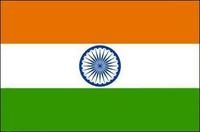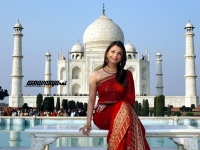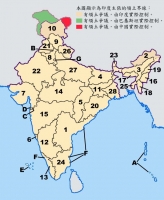南亞:
|
| 印度 India 首都:新德裏 國家代碼: in |
|
印度共和國(The Republic of India).代碼IN
【國旗】 呈長方形,長與寬之比為3∶2。自上而下由橙、白、緑三個相等的橫長方形組成,白色長方形中心繪有24根軸條的藍色法輪。橙色象徵勇敢和自我犧牲精神,也是教士法衣的顔色,捨身為國的英雄們的顔色;白色象徵純潔的真理;緑色表示信心,代表人類生命所依存的生産力。法輪是印度孔雀王朝阿育王時代佛教聖地石柱柱頭的獅首圖案之一,對於印度人而言,它是神聖之輪、真理之輪、嚮着進步轉動之輪,永遠輪回蒼穹之輪。 【國徽】 圖案來源於孔雀王朝阿育王石柱頂端的石刻。圓形臺基上站立着四衹金色的獅子,象徵信心、勇氣和力量。臺基四周有四個守衛四方的守獸:東方是象、南方是馬、西方是牛,北方是獅。守獸之間雕有法輪。圖案下面有句用梵文書寫的、出自古代印度聖書的格言“唯有真理得勝”。 【國歌】 《人民的意志》 【國花】 蓮花 【國鳥】 藍孔雀 【國樹】 菩提樹 、榕樹 【面積】 約298萬平方公裏(不包括中印邊境印占區和剋什米爾印度實際控製區等)。印度政府稱其領土為328.78萬平方公裏。印度面積居世界第七位。 【人口】 11.3億(2007年)。有10個大民族和許多小民族,印度斯坦族占46.3%,泰盧固族8.6%,孟加拉族7.7%,馬拉地族7.6%,泰米爾族7.4%,古吉拉特族4.6%,坎拿達族3.9%,馬拉雅拉姆族3.9%,奧裏雅族3.8%,旁遮普族2.3%。英語和印地語同為官方語言。約有82%的居民信奉印度教,其次為伊斯蘭教(12%)、基督教(2.3%)、錫剋教(1.9%)、佛教(0.8%)和耆那教(0.4%)等。 【首都】 新德裏(New Delhi),連同老德裏人口共1280萬(2001年)。 【國傢元首】 總統現任總統是普拉蒂巴-帕蒂爾(女),2007年7月25日就任。 地理環境 印度位於印度次大陸,主要由三部分組成:在北部的喜馬拉雅山區(其中就有海拔8,598米的印度最高峰康城章加峰)、中央平原(Indo-Gangetic Plain)以及南部的德幹高原。 多條河流發源於或流經印度,例如有恆河、布拉馬普特拉河、亞穆納河、戈達瓦裏河以及奎師那河(Krishna River)。印度河上流的一小段也位於印度境內。印度屬熱帶季風氣候,氣溫變化較大。 象她的人民一樣,印度的地質、地理和風土代表了地球歷史的真正全貌。世界上最高而有最年輕的喜馬拉雅山形成了印度北部的一道讓人望而生畏的天然屏障,她東西綿延2500公裏,構成50萬平方公裏的面積。她最著名的西崖沉冰川是衝積成富饒的北部,西部山𠔌的萬年流淌的河流的永不枯竭的源泉。印度的聖河恆河,還有雅穆納河、信度河、布拉馬普特拉河從遠古時期就孕育了沿岸的富饒大地的文明。到了西北部,有世界上最古老的、數百萬年以來不再榮耀、不再肥沃的阿拉瓦裏山係。 文迪亞山和薩特普拉山脈從東到西平行橫貫幾乎整個印度半島。撒黑亞得裏山平行橫貫印度西海岸,東海岸的不規則山係為東高止山。每個山係的漂亮景點星羅棋布,現代化的交通工具四通八達。喜馬拉雅山有許多滑雪場,還有安全的爬山和河上漂流設備。每個山脈有其獨特的雄偉壯麗和地理特點。茫茫林海,特別是亞熱帶森林裏生活着各種野生動物,森林裏建有野生動物保護區,遊客可以大飽眼福,觀賞百獸千鳥。靠近撒黑亞得裏山海岸特別是剋拉拉邦,果阿和瑪哈施特拉邦的共幹地區碧緑的阿拉伯海岸有數不清的美麗的山峽、峽灣、小溪和潟湖,令無數的遊客渴望在難得美麗的寧靜環境中陶冶性情。印度有7516公裏的海岸綫,阿拉伯海和孟加拉灣為太陽浴和水上運動愛好者提供舒適優美的場地和環境。 溫迪亞山和薩特普拉山是納瑪達河、達菩提河、戈達瓦裏河、剋裏西納河、瑪哈那底河以及漕沃瑞河的發源地。這些河流以及東部的布拉馬普特拉河經歷了許多古代王朝和文化的興衰,半島上到處可以看到古代遺址和殘存的紀念碑。印度南部的泰米爾文化甚至早於北部的吠陀文明,泰米爾人以他們的語言比梵語古老而引以自豪。 印度位於北緯8.4至37.6度之間,氣候差異很大。當喜馬拉雅山麓剋什米爾山𠔌的拉達剋和旁遮普氣溫在0度上下徘徊,冷得結冰的時候,半島南部氣溫卻在30度,熱得汗流浹背。每年6到9月為印度的夏季西南季風期,是印度半島大部分地區農業耕種季節,但滂沱大雨給耕種帶來睏難。不過從南到北的灌溉係統可以調節這種不利因素。具有創新精神的印度憑着勤勞和智慧已經戰勝了季風的肆虐。過去常常遇到饑餓災年的印度,在養活是1947年獨立時三倍的人口的同時,還嚮外出口糧食和水果。 國傢歷史 世界四大文明古國之一。公元前2000年前後創造了印度河文明。約在公元前14世紀,原居住在中亞的雅利安人中的一支進入南亞次大陸,並徵服了當地土著。約公元前1000年,開始形成以人種和社會分工不同為基礎的種姓制度。公元前4世紀崛起的孔雀王朝開始統一印度次大陸,前3世紀阿育王統治時期疆域廣阔,政權強大,佛教興盛並開始嚮外傳播。中世紀小國林立,印度教興起。自11世紀起,來自西北方向的穆斯林民族不斷入侵並長期統治印度。1526年建立莫臥兒帝國,成為當時世界強國之一。1600年英國侵入,建立東印度公司。1757年開始淪為英殖民地,1849年全境被英占領。1857年爆發反英大起義,次年英國政府直接統治印度。1947年6月,英將印度分為印度和巴基斯坦兩個自治領。同年8月15日,印巴分治,印度獨立。1950年1月26日,印度共和國成立,為英聯邦成員國。 國傢政治 印度獨立後長期由國大黨統治,反對黨曾在1977年~1979年和1989年~1991年兩次短暫執政。1996年以來印度政局不穩,到1999年先後舉行3次大選,産生了5屆政府。本屆政府於1999年10月第十三屆人民院選舉産生,以印度人民黨為首的24黨“全國民主聯盟”獲勝,瓦傑帕伊為總理。 全國民主聯盟政府較前幾屆政府穩定。政治上謀求國內政局和社會穩定,經濟上實行“第二階段經濟改革”,外交上加速推進全方位大國外交戰略。 【憲 法】 憲法於1950年1月26日生效。規定印度為聯邦製國傢,是主權的、社會主義的、世俗的民主共和國。采取英國式的議會民主製。公民不分種族、性別、出身、宗教信仰和出生地點,在法律面前一律平等。總統為國傢元首和武裝部隊的統帥,由聯邦議會及邦議會組成選舉團選出,每屆任期五年。總統依照以總理為首的部長會議的建議行使職權。 【議 會】 由聯邦院(上院)和人民院(下院)組成。聯邦院共244席,議員由各邦及中央直轄區立法院議員選舉産生,任期六年,每兩年改選1/3。聯邦院每年召開四次會議。憲法規定副總統為法定的聯邦院議長。現任聯邦院議長帕伊隆·辛格·謝卡瓦特(Bhairon Singh Shekhawat),2002年8月19日就任。人民院為國傢主要立法機構,其主要職能為:製定法律和修改憲法;控製和調整聯邦政府的收入和支出;對聯邦政府提出不信任案,並有權彈劾總統。人民院共543席,由選民直接選舉産生,每五年舉行一次大選。第13屆人民院於1999年10月産生,印度人民黨及其盟黨獲301席,組建政府。2002年,人民院組成為:印度人民黨及其盟黨306席,印度人民黨181席,為第一大黨;國大黨(英)及其盟黨123席,國大黨112席;左翼政黨及盟黨63席,其餘政黨50席。人民院議長馬諾哈爾·喬希(Manohar Joshi),2002年5月10日就任。 【政 府】 本屆政府於1999年10月13日組成,是以印度人民黨為首的24黨全國民主聯盟政府。現主要內閣成員有:總理阿·比·瓦傑帕伊(Atal Bihari Vajpayee)、副總理兼內政部長阿德瓦尼(L..K.Advani)、外交部長亞施旺特·辛哈(Yashwant Sinha)、財政部長賈斯旺特·辛格(Jaswant Singh)、國防部長喬治·費爾南德斯(George Fernandes)。 【司法機構】 最高法院是最高司法權力機關,有權解釋憲法、審理中央政府與各邦之間的爭議問題等。各邦設有高等法院,縣設有縣法院。最高法院法官由總統委任。現任第34屆首席法官V·N·卡爾(V N Khare),於2002年12月就任。總檢察長由總統任命,其主要職責是就執法事項嚮政府提供咨詢和建議,完成憲法和法律規定的檢察權,對憲法和法律的執行情況進行監督等。現任總檢察長S·J·索拉伯吉(Soli J.Sorabjee)。 【政 黨】 (1)印度人民黨(Bharatiya Janata Party):1980年4月成立,其前身是1951年成立的印度人民同盟。自稱有350萬黨員。代表北部印度教教徒勢力和城鎮中小商人利益,具有強烈民族主義和教派主義色彩。1996年5月大選至今一直保持議會第一大黨地位。現任黨主席為奈杜(Naidu)。 (2)印度國民大會黨(英迪拉·甘地派)(The Indian National Congress〔Indira Gandhi〕):簡稱國大黨(英)。據稱有初級黨員3000萬,積極黨員150萬。1885年12月成立,領導了反對英國殖民統治和爭取印度獨立的鬥爭。印獨立後長期執政,1969年和1978年兩次分裂。1978年英·甘地組建新黨,改用現名。該黨現為最大在野黨,現任主席索尼亞·甘地(Sonia Gandhi)。 (3)印度共産黨(馬剋思主義)(Communist Party of India〔Marxist〕):簡稱印共(馬)。1964年以孫達拉雅和南布迪裏巴德為代表的一派從印度共産黨分出後組成。近年來發展較快,黨員增至70萬,是印度最大的左翼政黨。在西孟加拉邦長期執政。現任總書記哈·辛·蘇吉特(H.S.Surjeet)。 (4)印度共産黨(Communist Party of India):成立於1920年。有黨員54萬。1964年分裂,以黨主席什·阿·丹吉為首的一派仍沿用印共名稱。1981年4月,丹吉因支持英·甘地與黨內發生分歧而被開除出黨,該黨再次分裂。現任總書記A·B·巴爾丹(A·B·Bardan)。 (5)泰盧固之鄉黨(Telugu Desam Party),安得拉邦地方政黨。近年來是印度政壇的一支重要力量,1999年大選成為全國最大的地方政黨。在安得拉邦執政,黨主席、邦首席部長錢·奈杜(Narra Chandrababu Naidu)以重視信息技術著稱。 【重要人物】 阿卜杜爾·卡拉姆:總統。1931年10月15日生於泰米爾納杜邦,穆斯林,無黨派。早年就讀於蒂魯奇聖約瑟夫學院和馬德拉斯技術學院,分別獲得理學士和航空技術博士學位。自1958年起,先後在印國防部下屬的空軍技術開發和生産理事會、航空發展局、印太空研究委員會從事科學研究。是印空間研究組織的締造者之一。1982年起擔任國防研究和發展研究所所長,負責實施印度導彈綜合發展計劃,研發了大地、烈火、三叉戟、眼鏡蛇等自産導彈,被譽為印度的導彈之父。1981年、1990年和1997年分別獲印度三級、二級和最高榮譽一級勳章,出任印政府首席科學秘書。著有自傳《火之翼》和《印度2020--新千年藍圖》等書,希望通過科技治國,印度在2020年躋身發達國傢行列。 阿塔爾·比哈裏·瓦傑帕伊:總理。1926年12月生於印度中央邦瓜廖爾一個教師家庭。獲文學碩士學位。1951年參加人民同盟創建工作(該同盟為印度人民黨的前身)。自1957年起,多次當選印度人民院和聯邦院議員。1977年,英·甘地實行緊急狀態期間被捕入獄。出獄後,他領導的人民同盟與其他黨派共同組建人民黨,並在當年的大選中獲勝,建立了印度獨立後的第一個非國大黨政府,瓦任外交部長。1979年訪華。1980年,人民黨分裂,以瓦為首的原人民同盟脫離人民黨,另外組建印度人民黨。瓦先後出任該黨主席、議會黨團領袖。1996年大選後,印度人民黨成為議會第一大黨,瓦曾出任內閣總理13天。1998年3月再度擔任總理。1999年10月,以印度人民黨為首的24黨全國民主聯盟在提前進行的第13屆人民院大選中獲勝,瓦第三次出任總理。 國傢經濟 獨立後經濟有較大發展。農業由嚴重缺糧達到基本自給。工業已形成較為完整的體係,自給能力較強。印度政府於1991年7月開始進行全面經濟改革,放鬆對工業、外貿和金融部門的管製,1992至1996年經濟年均增長率為6.2%。九·五計劃(1997至2002年)期間經濟年均增長率有所下降,為5.4%。2001年,印出臺十·五計劃,將2002年-2007年的經濟增長率定為年均8%。 2001/2002年度,政府繼續深化第二階段經濟改革,加速國有企業私有化,實行包括農産品在內的部分生活必需品銷售自由化,改善投資環境,精簡政府機構,削減財政赤字。由於農業和服務業的快速發展,印經濟增長率達到5.6%,較上年提高了1.6%。 國內生産總值(2001/2002年度):209400億盧比 國內生産總值增長率(2001/2002年度):5.6% 貨幣名稱:印度盧比(Rupee) 匯率(2002年7月):1美元=48.83盧比 年均通貨膨脹率(2001/2002年度):4.3% (資料來源:印度中央統計署2003年1月公佈數據) 【工 業】 2001/2002年度,工礦業比上年度增長2.7%,産值33680億盧比,占國內生産總值的26.4%,是過去10年以來增長最慢的一年。其中製造業2.4%,電力工業2.7%,礦業1.1%,初級、中間産品和消費品的增長都較上年有大幅減少。近年來,印度紡織、食品、精密儀器、汽車、軟件製造、航空和空間等新興工業發展迅速。 主要工業産品産量如下(單位:萬噸): 1999/2000 2000/2001 2001/2002 煤 30000 30963 32779 鐵礦砂 7270 7770 n.a. 原油 3195 3243 3203 天然氣(億立方米) 284.5 294.8 297.1 水泥 9821 9761 10690 鋼材 2440 2927 3064 化肥(氮、磷肥) 1430 1470 n.a. 布(億平方米) 236 402 n.a. 發電量(億度) 4807 4996 5153 汽車(萬輛) 87.5 79.7 83.4 (資料來源:印度政府2002/2003年度經濟概覽, n.a.暫無統計) 【農 業】 2001/2002年度農業及相關産業增長率5.7%,産值30205億盧比,占國內生産總值的24.7%。由於全年降水的時間和地區分配均勻,糧食産量增長6.3%,為2.12億噸。糧食儲備目前已達5000萬噸。農村人口約占全國的72%。全國耕地面積約1.6億公頃,人均0.17公頃。印度是世界第一大産奶國,2001/2002年度牛奶産量約為8460萬噸,人均每天226剋。印也是世界重要的産棉國和産茶國。 近些年主要農副産品産量如下(單位:萬噸): 1999/2000 2000/01 2001/02 糧食總産量 20890 19590 21200 稻 米 8950 8490 8310 小 麥 7560 6870 7180 牛 奶 7810 8100 8460 油 料 2070 1840 2050 甘 蔗 29920 29920 30010 茶 83.5 84.8 84.7 皮棉(萬包)* 1160 970 1010 黃麻(萬包)** 1050 1050 1160 註 * 每包皮棉為170公斤。 ** 每包黃麻為180公斤。 (資料來源:印度政府2002/2003經濟概覽) 【服 務 業】 80年代以來以高於其他産業的速度發展。1993-2000年,印服務業實現了7.1%-10.5%的高速增長。2001/02年度,服務業比上年增長6.5%,總産值為61630億盧比,占國內生産總值的48.8%。從業人數1994年為1261.8萬人,其中85.2%為政府機關和國營部門職工。印度軟件製造與服務業近幾年來以年均超過50%的增長率迅速發展,2001/02年度軟件總産值 98.6億美元,其中出口78億美元。政府計劃到2008/2009年度,印軟件産值將達到870億美元,出口500億美元。 【旅 遊 業】 政府已將旅遊業作為社會效益良好的創匯産業列入發展重點,該産業已成為全國第六大出口創匯部門。1999年各類旅館1229傢。近年來,外國旅遊者人數逐年遞增,旅遊收入不斷增加。受9·11事件影響,印度2001/02年度的外國遊客量下降了10.2%,人數242.3萬,收入下降8.1%,為29.1億美元。主要旅遊點有阿格拉、德裏、齋浦爾、昌迪加爾、納蘭達、邁索爾、果阿、海德拉巴、特裏凡特琅等。 【交通運輸】鐵路是最大的國營部門,亦為主要運輸手段,總長度居亞洲第一位,世界第四位。鐵路部門實行單獨預算,每年與中央財政預算一起提交議會討論通過。近年來,公路運輸發展較快,已承擔了全國貨運量的60%,為世界最大的公路網之一。海運能力居世界第18位。 鐵路:2001/2002年度鐵路綫總長6.31萬公裏,其中電氣化鐵路1.57萬公裏,約占鐵路總長的25%;2001/2002年度客運量4930億人公裏,貨運量為3332億噸公裏,鐵路運輸總收入3783.7億盧比,比上年增長8..5%。 公路:2001/02年度總長約330萬公裏,其中國傢級路5.8萬公裏。1999/2000年度登記的各種機動車輛約4839萬輛,其中客車55.9萬輛,貨車268.1萬輛,公路運輸總收入為3393.3億盧比。目前,公路承擔着全國80%的客運量和60%的貨運量,全國日平均客運量逾6000萬人次。 水運:印有港口共約200個,其中12個大港口和184個中小港口。內陸可航行河道總長約1.4萬公裏,實際使用的不足30%。印有83傢海運公司,其中19傢承擔遠洋運輸業務,49傢承擔近海運輸業務,其餘兩兼。到2002年3月,印全國水運總能力為3.44億噸,2001/2002年度印水運貨運總量為2.88億噸。印還在十·五計劃中將主要港口的總貨運量提高到4.7億噸。孟買為全國最大港口,海運的1/5和集裝箱運輸的1/2經過這裏;其他重要海港有加爾各答、馬德拉斯、科欽、果阿等。 空運:印航空公司有:印度國際航空公司、印度航空公司和其他42傢私營航空公司。2001/2002年度,旅客數量為3998.3萬,貨運量為85.4萬噸。航綫通達各大洲主要城市。全國有德裏、孟買、加爾各答、馬德拉斯和特裏凡特琅五個國際機場;國內機場92個。 【財政金融】 中央和地方財政分立,預算有聯邦和邦兩級。每年4月1日至次年3月31日為一個財政年度。多年來推行赤字預算以刺激經濟發展,中央和邦級地方債務纍積占國內生産總值的80%,龐大的赤字已成為經濟中主要的不穩定因素。2001/2002年度政府財政赤字相當於國內生産總值的10%。為解决赤字問題,印政府提交了財政責任與預算管理法案,目標是到2006年將中央政府赤字削減到占國內生産總值的2%,並在2011年前大幅降低政府債務規模。 近年中央和地方財政狀況如下(單位:億盧比): 99/2000 2000/01 2001/02 總收入 54261.6 59796.3 67099.1 總支出 54581.3 59561.7 67812.9 財政赤字 -18482.6 -19985.3 -22871.6 (資料來源:印度政府2002/2003經濟概覽) 截至2002年12月,印外匯儲備(包括黃金儲備和特別提款權)為704億美元。到2001年9月,外債為996.1億美元,占國內生産總值的21%,其中短期債務占總債務的比重從1991年3月的10.2%降到2001年9月的2.8%。 【對外貿易】 近年來,由於進口增加、出口不振,貿易赤字日益嚴重,成為國際收支失衡的主要原因。近幾年外貿情況如下(單位:百萬美元): 1999/2000 2000/01 2001/02 進口額 55383 59264 57618 出口額 37542 44894 44915 差 額 -17841 -14370 -12703 (資料來源:印度政府2002/2003印度經濟概覽) 2001/02年度,印出口增長0.8%,進口下降0.2%,貿易逆差與非貿易盈餘基本相抵,經常賬戶大體平衡。2002年1月,印政府公佈2002-2007年中期出口戰略,計劃以下列部門為重點將年出口總額增加到800億美元:工程、機電、電子、紡織、寶石和首飾、化工、農業、皮革和鞋類。該年度印主要進口商品為:珍珠、寶石、電子産品、金銀、化工産品、石油及其製品、燃料、資本貨物、化肥、鋼鐵、造紙原料、紙張等。主要出口商品為:珠寶製品、棉紗及棉織品、化工製品、機械及五金製品、石油製品、皮革及其製品、農業及相關半成品、海産品、鐵礦砂及礦産品等。主要進出口方向是歐盟(比利時、法國、德國、荷蘭、英國)、北美地區(加拿大、美國)及澳大利亞和日本。 【外國資本】 印度從1991年起實行積極吸引外資的新政策。1991年至2000年,外國直接投資協議金額達639億美元。 2001/2002年度,印吸收外國投資52.8億美元,其中直接投資39億美元。到2002年10月,對印投資最多的國傢分別是:毛裏求斯、美、日、英、德、荷蘭、韓、法、意和新加坡。吸引外資多的行業是能源、通訊、電子設備、運輸業、服務業、化工、旅館和旅遊、紡織業等。 【外國援助】 印是世界上主要的受援國之一。2001/2002年度獲貸款及捐贈總額為2509.5億盧比,約為51.5億美元,實際利用外援1755.9億盧比,約為36億美元。近年取得外援情況如下(單位:億盧比): 1999/2000 2000/01 2001/02 國際復興開發銀行 36.78 720.85 803.70 國際開發協會 352.69 413.53 444.00 日 本 374.23 272.98 205.80 亞洲開發銀行 216.30 526.50 672.50 德 國 41.00 38.60 41.20 英 國 204.10 47.40 194.40 美 國 7.45 8.11 12.20 荷 蘭 13.37 7.03 33.2 (資料來源:印度政府2002/2003年度經濟概覽) 【人民生活】 2001/2002年度印度人均收入為378美元。據印度官方公佈資料,1999/2000年度印生活在貧睏綫以下的人口為2.6億,占印總人口的26.1%,其中75%的貧睏人口生活在農村,人數1.93億。印度歷屆政府將消除貧睏作為經濟發展的首要任務之一,十·五計劃中製定了減少貧睏人口的目標,2007年要將貧睏人口數量減少到2.2億,占總人口的19.3%。1999/2000年度印度失業率為7.32%。2000/01年度,印消費價格指數上升5.2%。到2000年,全國有各類診療所和醫院4.3萬傢,登記行醫人員50.39萬人,登記護士73.7萬人。2000年,人口預期壽命為65歲,人口出生率25.8‰,死亡率8.5‰。 國傢軍事 印軍前身為英國殖民主義者的雇傭軍。1947年印巴分治後始建分立的三軍。1978年創建獨立的海岸警衛隊。總統是名義上的武裝力量統帥,內閣為最高軍事决策機構。國防部負責部隊的指揮、管理和協調。各軍種司令部負責擬定、實施作戰計劃,指揮作戰行動。現陸軍參謀長上將S. 潘德馬那巴汗(S.Padmanabhan),空軍參謀長上將S.剋裏希納斯瓦米(S.Krishnaswamy),海軍參謀長上將M.辛格(M. Singh)。實行募兵製。陸、海、空三軍總兵力為127萬,居世界第四位。其中陸軍103.5萬,分東、南、西、北和中央五大軍區,擁有中程導彈,已具備核能力。海軍7萬,分為西、東二支艦隊和南部科欽訓練基地;孟買和維沙卡帕特南為最大的海軍基地,分別是西、東艦隊司令部所在地。1999年新成立遠東軍區,司令部設在布萊爾港。空軍17萬,分成西、西南、東、南和中央五個軍區,擁有米格29、幻影2000等先進作戰飛機。海岸警衛隊分西岸、東岸、安達曼和尼科巴三個大隊,指揮部分設於孟買、馬德拉斯和布萊爾港。另有50多萬預備役軍人和100多萬準軍事部隊。 1998年5月,以印度人民黨為首的聯合政府進行核試驗,堅持建立最低有效核威懾。 1999年8月17日,印國傢安全顧問委員會提出核構想草案,提出印要建立陸基、空基、海基三位一體的戰略核力量,強調印將奉行擁有可信的最低限度的核威懾力的理論,稱印擁有核武器的根本目的是為了阻止任何國傢或實體對印及其部隊使用和威脅使用核武器,承諾不首先使用核武器以及不對無核國傢動用核武器。 2003年1月,印正式全面出臺核政策框架,成立核指揮機構及其直屬戰略部隊司令部,核指揮機構由總理、國防、內政、外交和財政部長、各軍種參謀長等組成的政治委員會控製。 2001/2002年度國防預算開支為6200億盧比(約合132億美元),比上年增長13.8%。 文化教育 【文化】 印度已知的歷史可以追溯到公元前2000年,以雅利安人第一次在印度北部定居的移民浪潮為開始。很可能在移民和當地居民之間發生了激烈衝突。但顯然是偉大的印度的同化精神和忍耐精神取勝,這種精神一直持續到現在。在以後的一千年間雅利安人遍布整個印度,創造了大部分早期的古典梵語文獻,如《梵經》、《吠陀經》、《奧義書》和兩大史詩《羅摩衍那》和 《摩訶婆羅多》。 印度到處是無數歷史紀念碑。 一些保存佛祖骨灰的古老佛塔、刻有法令的阿育王柱、銅匾和石碑散布在整個次大陸。瑪哈拉施特拉邦等地有雕刻精美的阿旃塔石窟、愛羅拉石窟、艾勒凡塔石窟,東南西北有保存完好的不同建築風格的雄偉的廟宇,拉加斯坦的城堡和莊園、德裏的壯麗的紅堡、歷史紀念碑、壯觀的法特普爾西剋裏王宮、宏偉美麗的泰姬陵……數說不完的名勝古跡。遊客一旦被吸引到神化般的印度來,會讓他千眼萬眼看不夠。 現代印度是一個充滿活力的國傢, 就透明的民主性而言,她又是世界上最大的國傢,應該為此感到自豪。二戰以後獨立的第三世界國傢中,有很少的國傢能象印度那樣這麽忠實地保護其民主制度。不可諱言,印度城鎮還有窮人,還有貧民窟。但隨着印度的科學和工業技術的發展,人民的生活水平會隨之提高,到了21世紀,一定會達到中等生活水平。印度的新興的信息技術工程人員和信息企業贏得了世界的尊敬。其國民生産總值增長率僅次於中國。印度人民决心在現代世界崛起,印度脈搏隨着人民的青春般的活力躍動。 印度的語言同樣多樣化。印度有大約2000種,其中55種有自己的文字和文學。有各自巨大的文學寶庫的發展完善的19種語言被承認為印度的官方語言。印度的每個宗教在次大陸都有它的信徒。印度的信仰印度的人占絶大多數,為85%,其次為穆斯林、基督教、佛教、猶太教、拜火教、耆那教等,所有不同宗教和諧相處。整個印度次大陸遍布無數的漂亮的廟宇、雄偉的教堂、宏大的清真寺、香火旺盛的佛教廟、猶太教堂和拜火教寺院。印度西部商業特大都市孟買可以說是印度宗教、種族、語言多樣性的一個縮影。市內除了以上各教的廟、堂外,還有有著名的亞美尼亞教堂、神道教廟和大同教廟等。 【教育】 實行12年一貫製中小學教育。高等教育共8年,包括3年學士課程、2年碩士課程和3年博士課程。此外還有各類職業技術教育、成人教育等非正規教育。2001/2002年度,印政府教育經費占國民生産總值的3.99%,成人識字率為65.38%。2000/01年度中小學入學率81.6%,但小學綴學率為40.7%,初中綴學率為53.7%。全國現有254所綜合性大學,著名的有德裏大學、尼赫魯大學、加爾各答大學等。至2000/01年度,各級學校、學生和教師情況如下: 學校(萬所) 在校人數(萬人) 高等院校 1.04 606* 高級中學 12.6 2880 初級中學 20.6 4280 小 學 63.87 11380 * 為1996年數字。 (資料來源:印度政府2002/2003年度經濟概覽) 【新聞出版】 印報刊大多屬私人和財團所有。到1993年底,全國共有96種文字的報刊33612種,總發行量為6761.1萬份。印地文和英文報刊分別占總數的37%和16%。報刊中,最大的三傢日報依次為《印度時報》、《馬拉雅拉娛樂報》和《古吉拉特新聞》。主要印地文報紙有《旁遮普之獅報》、《今天日報》、《印度斯坦報》等;主要英文報紙有《印度斯坦時報》、《政治傢報》、《印度教徒報》、《印度快報》等。 主要新聞機構和通訊社有:(1)新聞發佈署:相當於政府中央通訊社,擁有1100多名國內和180多名國外特派記者,電傳網覆蓋全國各地,8000余家新聞單位供稿。設有8個地區總分社和27個分社。(2)印度報業托拉斯:印最大通訊社,半官方性質。成立於1947年8月,後兼併印聯合通訊社和路透社印度支社,於1949年元旦開業。現設136個國內分社和11個海外分社,員工1000多名,海外記者30多名。英文日發稿量超過10萬字。在北京派駐記者。(3)印度聯合新聞社:印第二大通訊社,係報業同仁的合股企業。1959年登記成立。現有分社100多個。目前嚮四個海灣國傢及新加坡、毛裏求斯提供新聞服務,在迪拜、華盛頓和新加坡設有分社,22個國傢派駐了記者。(4)印度斯坦新聞社:私營,主要編發印地文、馬拉地文、古吉拉特文和尼泊爾文的新聞。 全印廣播電臺隸屬政府新聞廣播部,廣播網覆蓋全國人口95%。對內使用23種語言播音,日播音75小時15分鐘。擁有100多名國內記者,7個國傢派有常駐記者。 全印電視臺於1959年9月試播,1976年脫離全印廣播電臺成為獨立機構,隸屬新聞廣播部。全國現有18傢電視臺,6個邦開通了衛星電視接收。電視網覆蓋全國人口的86%。 對外關係 印為不結盟運動創始國之一,歷屆政府均強調不結盟是其外交政策的基礎,努力與所有國傢發展關係,力爭在地區和國際事務中發揮重要作用。冷戰結束後,印政府調整了過去長期奉行的傾嚮蘇聯的大國平衡政策,推行全方位務實外交,創造有利於自身發展的持久和平穩定的地區環境。 近年來,隨着綜合國力不斷增強,印加快推進大國外交戰略。強調外交為經貿服務,在保持與俄羅斯及其他獨聯體國傢關係的同時,大力發展與美、日、歐等發達國傢的關係,尤其是經貿科技合作,吸收資金和技術。與東盟及亞太地區國傢的關係發展迅速,1996年正式成為東盟全面對話國並參加東盟地區論壇;積極要求加入亞太經合組織工作組和亞歐會議;1997年參加“孟印緬斯泰經濟合作組織”;2000年11月與泰、緬、越、老、柬共同成立“湄公河-恆河合作計劃”。1997年倡導建立了環印度洋區域合作聯盟。重視能源安全,逐步拓展同海灣、中亞等能源供應國的交往與合作。到1999年7月,同163個國傢有外交關係。 印主張在和平共處五項原則及聯合國宗旨和原則的基礎上建立公正合理、考慮到所有國傢利益並能為所有人接受的國際政治新秩序,要求進一步加強南南合作和南北對話,呼籲各國共同創造一個有利於第三世界發展的公正合理的新經濟秩序。建議立即擴大安理會,以增加其代表性,實現决策民主化,提高工作效率。 1992年聯大期間正式嚮大會提出成為安理會常任理事國的要求,強烈反對美等西方國傢提議讓德國和日本自動成為安理會常任理事國,要求經過地區協商一致程序討論發展中國傢成為常任理事國的問題,要求聯合國先就進入安理會的資格達成一致,然後决定擴大安理會的方案,積極參加聯合國維和行動。 1998年5月,以印度人民黨為首的聯合政府進行核試驗,堅持建立“最低有效核威懾”。 1999年8月17日,印國傢安全顧問委員會提出“核構想草案”,強調印將奉行擁有可信的最低限度的核威懾力的理論,稱印擁有核武器的根本目的是為了阻止任何國傢或實體對印及其部隊使用和威脅使用核武器,承諾不首先使用核武器以及不對無核國傢動用核武器。 在人權問題上,主張推進人權應考慮各國的具體情況,認為最根本的人權是生存的權利;對發展中國傢來說,發展問題優於民主和人權,反對將人權問題政治化,反對利用人權干涉他國內政,從而損害別國的主權和統一。 重視全球環境保護問題,認為環境問題正成為國際上最令人關註的問題,解决這一問題應與發展中國傢的發展要求相聯繫,環保的主要責任應由發達國傢承擔,建議發達國傢和發展中國傢聯合從事研究和開發來解决環境問題。 關註阿富汗局勢,支持維護阿的獨立、主權與領土完整,反對外國干涉阿內政。支持阿拉伯人民的正義鬥爭,認為中東問題的關鍵是巴勒斯坦問題,近年來,與以色列和巴勒斯坦等阿拉伯國傢的關係都有發展。到1999年7月,同163個國傢有外交關係。 2001年印外交活躍,加速推進全方位大國外交戰略。大國關係上,印與俄、美、英等國先後實現高層互訪。此外,今年到印訪問的還有聯合國秘書長安南、德國總理施羅德、日本前首相森喜朗、法國外長維德裏納、蒙古總統巴嘎班迪、希臘總理西米迪斯等訪印。在東盟方向,印大力推行“東嚮政策”,年內,瓦傑帕伊總理先後訪問了越南、印尼、馬來西亞。 2002年印繼續推進全方位大國外交戰略。印積極推動與美國的新型夥伴關係,強化同俄羅斯的戰略夥伴關係,繼續改善與中國的關係,積極發展同東盟關係,並改善南亞周邊國傢的關係。9·11事件後,印巴關係圍繞印要求巴停止跨界恐怖活動持續緊張。2002年,印巴在邊界集結重兵對峙。在國際社會的積極斡旋下,10月印巴開始分階段撤軍,兩國關係出現緩和跡象,但雙方仍未恢復和談。 印關註阿富汗局勢,支持維護阿的獨立、主權與領土完整,反對外國干涉阿內政,積極參與阿戰後重建工作。支持阿拉伯人民的正義鬥爭,認為中東問題的關鍵是巴勒斯坦問題,近年來,與以色列和巴勒斯坦等阿拉伯國傢的關係都有發展。 【同我國的關係】 1950年4月1日中印建交。1959年西藏叛亂後,中印關係惡化。1962年10月,中印邊境發生大規模武裝衝突。1976年雙方恢復互派大使後,兩國關係逐步改善。1988年、1992年、1993年、1994年印度總理拉吉夫·甘地、總統文卡塔拉曼、總理拉奧、副總統納拉亞南先後訪華。1991年、1993年、1994年、1995年、1996年李鵬總理、全國政協主席李瑞環、錢其琛副總理兼外長、喬石委員長、江澤民主席分別訪問了印度。1998年,印度以“中國威脅”為藉口進行核試驗,使中印關係嚴重受挫。經我反復做工作後,印政府領導人多次表示願意尋求發展對華關係。1999年,印度外長賈斯旺特·辛格訪華, 雙方確認,中印關係發展的前提是互不視對方為威脅,基礎是兩國共同倡導的和平共處五項原則。中印關係由此步入改善和發展的進程。兩國在政治、經貿、科技、議會、軍事和文化等領域的交流與合作得到加強。 2000年,時逢中印建交五十周年,兩國關係得到進一步改善和發展。5月28日- 6月3日,應國傢主席江澤民邀請,印度總統納拉亞南對中國進行國事訪問。其他重要交往有: 3月6-7日,中印首輪司級安全對話在京舉行。 3月29日,應印度人民黨(BJP)邀請,中共中央對外聯絡部部長戴秉國訪印。4月28-29日,楊文昌副外長赴印度參加中印邊界問題聯合工作小組第12輪會談。 7月7-12日,印聯邦院副議長、各國議會聯盟理事會主席赫卜杜拉女士應邀對中國進行友好訪問。 8月29、31日,李鵬委員長在紐約出席千年議長大會期間,分別會見了議聯理事會主席、印聯邦院副議長赫卜杜拉女士和印人民院議長巴拉約吉。11月13日,中印邊界問題外交和軍事專傢小組第8次會議在北京舉行,雙方交換了描述邊境中段實控綫走嚮的樣圖,並就雙邊關係等問題交換了意見。 2002年,中國同印度的關係進一步改善和發展。1月13-18日 應印總理瓦傑帕伊邀請,國務院總理朱鎔基對印度進行正式訪問,先後訪問了阿格拉、德裏、孟買和班加羅爾。訪問期間,朱總理與瓦傑帕伊總理舉行了會談,並分別會見了印總統納拉亞南、副總統兼聯邦院議長坎特、人民院議長巴拉約吉、人民院副議長赫卜杜拉、反對黨領袖、國大黨主席索尼婭·甘地等。兩國領導人就雙邊關係及共同關心的地區、國際問題等廣泛交換了意見。雙方再次確認中印互不構成威脅,並就共同加強經貿等各領域的合作達成廣泛共識。雙方簽署了包括旅遊、空間、水文、科技、植物檢疫等領域的6個合作文件。6月4日,江澤民主席在阿拉木圖出席亞洲相互協作與信任措施會議峰會期間,會見了與會的印總理瓦傑帕伊。江主席對近年來中印關係取得的進展表示肯定,並歡迎瓦傑帕伊總理訪華。江主席還就當前印巴局勢闡述了中方的立場,希望印巴雙方通過對話緩解緊張局勢。 中印之間存在歷史遺留下來的邊界問題。中印邊界全長約2000公裏,分東、中、西三段。雙方爭議區共約12.5萬平方公裏,其中東段約9萬平方公裏,中段約2000平方公裏,西段約3.3萬平方公裏。最大的爭議在東段,印度占領着大約9萬平方公裏的中國土地。1989年6月至2000年4月,中印邊界問題聯合工作小組共舉行十二輪會談。1993年9月,雙方簽署了“關於在中印邊境實際控製綫地區保持和平與安寧的協定”。1995年,雙方互撤了駐紮在中印邊界東段旺東地區的兩對哨所,基本解决了兩國軍隊過於接近問題。1996年江澤民主席訪印期間,兩國簽署了“關於在中印邊境實控綫地區軍事領域建立信任措施的協定”。 為落實兩國達成的協定,雙方於1994年成立了中印外交和軍事專傢小組。2000年11月,該小組舉行了第八次會議,雙方交換了邊境中段實控綫走嚮的樣圖。2001年6月和12月,該小組舉行了第九和第十次會議。2002年3月、6月和10月,該小組舉行了第十一、十二和十三次會議。 【同俄羅斯等國傢的關係】 印與前蘇聯於1947年建交。1955年後,蘇聯開始嚮印提供巨額經濟、軍事援助。1971年,兩國簽訂“和平友好合作條約”,建立極為密切的雙邊關係。1991年底蘇聯解體後,印大力開展與俄羅斯和其他各獨立國傢的接觸交往。1993年,俄羅斯總統葉利欽訪印,兩國簽訂了“印俄友好合作條約”、“印俄防務合作協定”和“印俄貿易合作議定書”等九項協定。1994年,俄羅斯副總理尤裏·亞羅夫、國傢杜馬主席裏普金、總理切爾諾梅爾金先後訪印,印度總理拉奧實現訪俄,促使兩國在政治、經濟、軍事、文化、科技等各個領域的關係迅速恢復和發展。1995-1997年,印俄關係繼續回升。1997年3月,印度總理高達訪問俄羅斯。俄明確提出兩國建立“戰略夥伴”關係,重申支持印在剋什米爾問題上的立場和成為聯合國安理會常任理事國的要求。10月,印國防部長亞達夫訪問俄羅斯。俄重申不嚮巴基斯坦出售武器,雙方同意將兩國長期軍事技術合作協議有效期延長至2010年。1998-1999年,印俄關係全面提升。1998年5月,印核試後,俄反對對印進行經濟製裁;12月,俄總理普裏馬科夫對印進行正式訪問。 1999年5月,俄總統特使普裏科德剋和印外長辛格互訪,雙方主要討論了科索沃問題和雙邊關係,呼籲北約停止對南聯盟的軍事行動,重申將建立戰略夥伴關係,俄方承諾將兩國軍事合作提高到最高水平,將嚮印提供印要求的所有武器。 2000年,印俄關係得到進一步加強。2001年,印俄關係繼續穩步發展。2002年,印俄關係繼續得到鞏固,雙方進一步深化軍貿和軍技合作。 【同美國的關係】 50年代~60年代,兩國關係密切。1971年印與前蘇聯簽訂“和平友好合作條約”並發動肢解巴基斯坦的第三次印巴戰爭後,印美關係嚴重受挫。80年代後期關係有所恢復,近年來得到進一步發展。目前,美是印最大的貿易夥伴和投資國。1998年,印美關係因印進行核試而受到嚴重影響。爾後印外長辛格與美副國務卿塔爾博特舉行了多輪會談,兩國關係有了很大的緩和和發展。 2000年,印度積極拓展同美國關係。2001年,印度繼續鞏固印美關係發展的勢頭。2002年,印積極推動同美國關係,雙方在軍事領域的交流與合作發展迅速。 【同歐盟國傢的關係】 2000年,印與歐盟建立首腦會晤機製,成為繼中國之後第二個與歐盟建立類似機製的發展中國傢。歐盟是印最大的貿易夥伴,雙方貿易額占印外貿的近30%。 2002年,印與歐盟國傢關係進一步發展。 【同東盟國傢的關係】 印度同東南亞國傢地理位置相近,有悠久的歷史關係,但因印1970-1990年間外交上推行親蘇政策及雙方在柬埔寨問題上存在分歧,印與東南亞國傢政治關係一般。九十年代,印積極推行東嚮政策,重視加強同東盟各成員國的交流與合作。1996年印成為東盟全面對話夥伴國,加入東盟地區論壇。1997年參加孟印緬斯泰經濟合作組織;2000年11月與泰、緬、越、老、柬共同成立湄公河-恆河合作計劃。 2002年,印度和東盟舉行首次領導人會議,建立印度--東盟10+1對話機製,標志雙方關係進入一個新階段。 【同巴基斯坦的關係】 1947年8月印巴分治後始終不睦,並於1948年、1965年和1971年三次爆發全面戰爭。1971年12月斷交,1976年7月復交。80年代關係有所緩和,近年來因剋什米爾爭端又不時出現緊張局面,邊境交火事件不斷。雙方領導人和官員為改善關係進行過多次對話和談判。1992年底,印度發生阿約迪亞毀寺事件後,在巴引起強烈反響,導致印巴關係下降。1993年,兩國關係因孟買爆炸案和哈茲拉特巴爾清真寺等事件繼續惡化。1994年,印巴關係因相互指責並驅逐對方外交人員而持續緊張。1995年,印巴就印控剋什米爾地區沙拉爾謝立夫城的聖陵和清真寺被毀事件相互指責,雙邊關係更趨緊張。1996年,印巴關係稍有緩和,但未取得實質性進展。1997年,印巴恢復政治對話和總理會晤,兩國關係出現緩和勢頭。1998年,印巴相繼進行核試驗,展開核軍備競賽,兩國關係急劇緊張。1999年2月,印總理瓦傑帕伊與巴總理謝裏夫簽署了《拉合爾宣言》,雙邊一度緩和。但4月印巴試射導彈,5月兩國在印控剋什米爾地區卡吉爾發生激烈衝突,印巴關係再次由緩和趨嚮惡化。12月,一架印民航班被劫持,印外長指責巴與此事有牽連。 2000年,印巴關係處於僵持狀態,年底氣氛有所緩和。2001年,印巴關係以“9·11”事件為界綫呈前緩後緊之勢。 2002年,印巴關係仍處於緊張對峙狀態。 【同其他鄰國的關係】 與南亞鄰國各方面聯繫較多,但也存在許多矛盾。1997年,印對鄰國政策做出重大調整,推行“多予少取”的“古傑拉爾主義”政策,與各國關係普遍得到明顯改善。1998年,印度核試引發南亞地區核軍備競賽,導致南亞局勢急劇緊張,南亞其他國傢對此僅作謹慎表態。1999年,印巴在剋什米爾地區爆發卡吉爾衝突,南亞局勢惡化,南亞其他國傢均對此表示關註,呼籲印巴兩國保持剋製和冷靜。2002年,印與南亞其他鄰國關係繼續有所發展。 風土人情 4大傳統儀式走遍全世界,入境隨俗是不變的真理。印度人有4大傳統儀式,分別是出生、葬禮、婚姻和普迦儀式。除此之外,在印度旅行,你一定要知道印度的10項特殊習慣和6大禁忌,保你玩得開心、一路平安。 出生 在印度的傳統上十分重男輕女,因為女兒結婚時,父母必須準備一筆豐富的嫁妝,如果沒有嫁妝,女兒是嫁不出去的。而這對於貧窮人傢而言,確實是一項龐大的負擔。 印度人如果生下的是女兒時,會用拍手示意,代表兩手空空來也。但如果生的是兒子時,那就大大不同了,傢人會立刻敲鑼慶祝,表示兒子將來娶老婆時,可以帶來響當當的嫁妝。 印度人慶祝小孩出生與平安成長的方式,就是到寺廟進行“普迦儀式”、唱頌祈禱文,然後和親朋好友舉行餐宴。 印度小孩出生後,父母都會找人為他們占卜,小孩的名字多半取自英雄或神祇。小孩的生辰八字尤其受到重視,因為這可以决定小孩未來的婚姻對象。 葬禮 印度教徒死亡時,都會在河壇舉行火葬儀式。印度教徒去世後,傢人會以黃色或白色絹布包裹屍體,然後放在兩根竹製擔架上,以遊行方式擡到河壇火葬地點。 傳統上,將死者擡送到火葬場的任務,應該由傢屬擔任,但是現在大部份的人都交給專人處理。在印度,專門處理喪葬事宜的人,都是被視為種姓地位最低的賤民。 一般送葬的儀式都非常簡單,但是比較富有的人傢,可能會請樂師在前面演奏,浩浩蕩蕩地遊行。火葬前,死者的長子必須手持油燈繞行遺體3次,當火葬柴堆被點燃時,死者長子必須將頭髮剃光,衹在後腦勺留一小撮,然後到河裏沐浴淨身。火葬結束後,死者骨灰會被掃到河裏,代表靈魂已經脫離軀殼、得到解脫。 婚禮 印度人的婚禮是社會地位的代表,也是一生中最重大的儀式。印度青年到了適婚年齡,都會由父母代為尋找社會階級、語言、區域、背景相同,以及星相可以配合的對象。 印度婚禮儀式相當繁瑣,結婚之前,雙方傢長會透過充當媒人的祭司討論嫁妝事宜,女方必須答應男女提出的嫁妝數量後,雙方纔選定黃道吉日、開始籌備婚禮。婚禮前一天,新娘必須根據傳統化妝方式,開始抹油、沐浴、更衣、梳頭、畫眼綫、抹唇砂、並且在腳上塗以紅色、在額頭點紅色蒂卡、在下巴點黑痣,接着還要用植物染料在手腳上繪飾漢那圖案,然後灑香水、配戴首飾和發飾,最後是把牙齒染黑、嚼檳榔、擦口紅,纔算大功告成。 婚禮當天,新郎官騎着一匹白馬浩浩蕩蕩地來到新娘傢。這時女方傢裏已經架起火壇,雙方親友在祭司念誦的吉祥真言中,繞行火壇祝禱。之後、新娘在女伴的簇擁下走到火壇前面,由祭司將新娘的紗麗和新郎的圍巾係在一起,代表婚姻長長久久。 印度婚禮的晚宴是在新娘傢裏進行,一對新人坐在婚宴中接受親友的祝福。婚禮當天晚上新郎是在新娘傢過夜,翌日纔將新娘迎娶回傢。 普迦儀式(Puja) 普迦是印度教中嚮神祇膜拜的儀式,普迦儀式必須由祭司擔任。儀式中信徒會將神像裝飾後擡出寺廟遊行慶祝,並且奉獻鮮花、椰子、蒂卡粉……等供品。最後再由祭司手持油燈,在神像前面進行“阿拉提(arati)”。 “阿拉提”的過程中,信徒用手輕輕覆蓋祭司手中的燈火,然後在自己的眼睛上碰觸一下,代表接受神祇賜予的力量。 通常在普迦儀式結束後,信徒可以分到一些祭祀過的鮮花、蒂卡粉或水,稱為“波拉沙達(Prasada)”。所以在印度,衹要看到印度人從寺廟膜拜出來,額頭上幾乎都塗有紅色或白色的粉末。 傳統服飾 在印度,可以由不同的服飾和裝扮,看出當地人的宗教信仰、種族、階級、區域等。 男性包頭巾: 印度男性多半包有頭巾,這種頭巾稱為Turban。頭巾有各式各樣的包裹方法,其中錫剋教男性頭巾,具有特定樣式。 根據傳統,錫剋人從小到大都必須蓄頭髮、留鬍須,並且包着頭巾。小孩頭巾樣式比較簡單,衹用黑布綁成發髻形狀。成年人的頭巾樣式比較復雜,首先必須用黑色鬆緊帶將長發束成發髻,然後再以一條長約3公尺的布,裹成頭巾,樣式為兩邊對襯成規則狀。錫剋人頭巾色彩繁多,有的人甚至搭配衣服顔色。 印度男性多半穿著一襲寬鬆的立領長衫(Tunic),搭配窄腳的長褲(Dhoti),拉賈斯坦地區男性,褲子是以一條白色布塊裹成的,頭上的布巾,花樣變化極多,色澤鮮明。 女性穿紗麗: 印度婦女傳統服飾是紗麗(Sari),紗麗是指一塊長達15碼以上的布料,穿著時以披裹的方式纏繞在身上。印度婦女擅長利用紮、圍、綁、裹、纏、披……等技巧,使得紗麗在身上産生不同的變化。 拉賈斯坦婦女的紗麗較短,衹有披覆在頭上,但是彩色繽紛、鑲有金銀綉邊。拉賈斯坦婦女的上衣,有點像似沒有領子的中國鳳仙裝,下身是一條滾邊的及地長裙。 紗麗穿著方式: 印度婦女傳統服飾,是用一塊長達3公尺的布包裹出來的,這塊布稱為紗麗(Sari)。印度紗麗的穿著方式變化繁多,不同的種族、區域、信仰,會有許多不同的色彩、質感和穿裹方式。印度婦女穿著紗麗時,上衣是一件短袖、露出肚臍的緊身衣(Choli),下身是一條及地的直筒襯裙(Ghagra)。 紗麗最基本的穿著方式,可以分為以下幾個步驟: 1. 首先拉住紗麗布左邊一端,塞進右側的襯裙裙頭。 2. 將紗麗布由右至左環繞下圍,約三、四圈。 3. 接着用紗麗布在右前方折成四折,並且塞入裙頭。 4. 然後將剩餘布塊,由左後方繞過右邊腋下,披嚮左邊肩膀上。 5. 最後直接將紗麗布披在肩上、或披覆在頭上。 自然資源 印度礦産資源豐富,鋁土儲量和煤産量均占世界第五位,雲母出口量占世界出口量的60%。截至1996年底,印度主要資源可采儲量估計為:煤463.89億噸(不含焦煤),鐵礦石97.54億噸,鋁土22.53億噸,鉻鐵礦1.24億噸,錳礦石6550萬噸,鋅589萬噸,銅352萬噸,鉛136萬噸,石灰石684.77億噸,磷酸????8100萬噸,黃金86噸,石油8.96億噸,天然氣6970億立方米。此外,還有雲母、石膏、鑽石及鈦、釷、鈾等礦藏。森林覆蓋率為21.9%。 Home to the Indus Valley Civilization and a region of historic trade routes and vast empires, the Indian subcontinent was identified with its commercial and cultural wealth for much of its long history. Four major world religions, Hinduism, Buddhism, Jainism and Sikhism originated here, while Zoroastrianism, Judaism, Christianity and Islam arrived in the first millennium CE and shaped the region's diverse culture. Gradually annexed by the British East India Company from the early eighteenth century and colonised by the United Kingdom from the mid-nineteenth century, India became a modern nation state in 1947 after a struggle for independence that was marked by widespread nonviolent resistance. India is the world's twelfth largest economy at market exchange rates and the fourth largest in purchasing power. Economic reforms have transformed it into the second fastest growing large economy; however, it still suffers from high levels of poverty, illiteracy, and malnutrition. A pluralistic, multilingual, and multiethnic society, India is also home to a diversity of wildlife in a variety of protected habitats. The name India (pronounced /ˈɪndiə/) is derived from Indus, which is derived from the Old Persian word Hindu, from Sanskrit Sindhu, the historic local appellation for the Indus River. The ancient Greeks referred to the Indians as Indoi (Ινδοί), the people of the Indus. The Constitution of India and common usage in various Indian languages also recognise Bharat (pronunciation (help·info), /bʰɑːrət̪/) as an official name of equal status. Hindustan (/hin̪d̪ust̪ɑːn/ (info)), which is the Persian word for “Land of the Hindus” and historically referred to northern India, is also occasionally used as a synonym for all of India. History Stone Age rock shelters with paintings at the Bhimbetka rock shelters in Madhya Pradesh are the earliest known traces of human life in India. The first known permanent settlements appeared over 9,000 years ago and gradually developed into the Indus Valley Civilization, dating back to 3300 BCE in western India. It was followed by the Vedic period, which laid the foundations of Hinduism and other cultural aspects of early Indian society, and ended in the 500s BC. From around 550 BCE, many independent kingdoms and republics known as the Mahajanapadas were established across the country. Paintings at the Ajanta Caves in Aurangabad, Maharashtra, 6th century.In the third century BCE, most of South Asia was united into the Maurya Empire by Chandragupta Maurya and flourished under Ashoka the Great. From the third century CE, the Gupta dynasty oversaw the period referred to as ancient "India's Golden Age." Among the notable South Indian empires were the Chalukyas, Rashtrakutas, Hoysalas, Pallavas, Pandyas, and Cholas. Science, engineering, art, literature, astronomy, and philosophy flourished under the patronage of these kings. Following invasions from Central Asia between the tenth and twelfth centuries, much of north India came under the rule of the Delhi Sultanate, and later the Mughal Empire. Mughal emperors gradually expanded their Kingdoms to cover large parts of the subcontinent. Nevertheless, several indigenous kingdoms, such as the Vijayanagara Empire, flourished, especially in the south. In the seventeenth and eighteenth century, the Mughal supremacy declined and the Maratha Empire became the dominant power. From the sixteenth century, several European countries, including Portugal, the Netherlands, France, and the United Kingdom, started arriving as traders and later took advantage of the fractious nature of relations between the kingdoms to establish colonies in the country. By 1856, most of India was under the control of the British East India Company. A year later, a nationwide insurrection of rebelling military units and kingdoms, variously referred to as the India's First War of Independence or Sepoy Mutiny, seriously challenged the British Company's control but eventually failed. As a consequence, India came under the direct rule of the British Crown as a colony of the British Empire. Mahatma Gandhi (right) with Jawaharlal Nehru, 1937. Nehru would go on to become India's first prime minister in 1947.During the first half of the twentieth century, a nationwide struggle for independence was launched by the Indian National Congress and other political organizations. In the 1920s and 1930, a movement led by Mahatma Gandhi, and displaying commitment to ahimsa, or non-violence, millions of protesters engaged in mass campaigns of civil disobedience. Finally, on 15 August 1947, India gained independence from British rule, but was partitioned with independent governments for the Dominion of India and the Dominion of Pakistan in accordance to wishes of the Muslim League, along the lines of religion to create the Islamic nation state of Pakistan. Three years later, on 26 January 1950, India became a republic and a new constitution came into effect. Since independence, India has suffered from religious violence, casteism and insurgencies in various parts, but has been able to control them through tolerance and constitutional reforms. Terrorism in India is also a major security problem, especially in Jammu and Kashmir, North-east India and recently in major cities like Delhi and Mumbai, 2001 Indian Parliament attack being the most prominent one. India has unresolved territorial disputes with China, which in 1962 escalated into the Sino-Indian War; and with Pakistan, which resulted in wars in 1947, 1965, 1971, and 1999. India is a founding member of the Non-Aligned Movement and the United Nations (as part of British India). In 1974, India conducted an underground nuclear test. This was followed by five more tests in 1998, making India a nuclear state. Beginning in 1991, significant economic reforms have transformed India into one of the fastest-growing economies in the world, adding to its global and regional clout. Government National Symbols of India Flag Tricolour Emblem Sarnath Lion Capital Anthem Jana Gana Mana Song Vandē Mātaram Animal Royal Bengal Tiger Bird Indian Peafowl Flower Lotus Tree Banyan Fruit Mango Sport Field hockey Calendar Saka The Constitution of India, the longest and the most exhaustive constitution of any independent nation in the world, came into force on January 26, 1950. The preamble of the constitution defines India as a sovereign, socialist, secular, democratic republic. India has a quasi-federal form of government and a bicameral parliament operating under a Westminster-style parliamentary system. It has three branches of governance: the Legislature, Executive, and Judiciary. The President of India is the official head of state elected indirectly by an electoral college for a five-year term. The Prime Minister is, however, the de facto head of government and exercises most executive powers. The Prime Minister is appointed by the President and, by convention, is the candidate supported by the party or political alliance holding the majority of seats in the lower house of Parliament. The legislature of India is the bicameral Parliament, which consists of the upper house called the Rajya Sabha (Council of States) and the lower house called the Lok Sabha (House of People). The Rajya Sabha, a permanent body, has 245 members serving staggered six year terms. Most are elected indirectly by the state and territorial legislatures in proportion to the state's population. The 543 of the Lok Sabha's 545 members are directly elected by popular vote to represent individual constituencies for five year terms. The other two members are nominated by the President from the Anglo-Indian community if, in his opinion, the community is not adequately represented. The executive branch consists of the President, Vice-President, and the Council of Ministers (the Cabinet being its executive committee) headed by the Prime Minister. Any minister holding a portfolio must be a member of either house of parliament. In the Indian parliamentary system, the executive is subordinate to the legislature, with the Prime Minister and his Council being directly responsible to the lower house of the parliament. India has a unitary three-tier judiciary, consisting of the Supreme Court, headed by the Chief Justice of India, twenty-one High Courts, and a large number of trial courts. The Supreme Court has original jurisdiction over cases involving fundamental rights and over disputes between states and the Centre, and appellate jurisdiction over the High Courts. It is judicially independent, and has the power to declare the law and to strike down union or state laws which contravene the Constitution. The role as the ultimate interpreter of the Constitution is one of the most important functions of the Supreme Court. Politics The North Block, in New Delhi, houses key government offices.India, at the federal level, is the most populous democracy in the world. For most of its democratic history, the federal government has been led by the Indian National Congress (INC). State politics have been dominated by several national parties including the INC, the Bharatiya Janata Party (BJP), the Communist Party of India (Marxist) (CPI(M)), and various regional parties. From 1950 to 1990, barring two brief periods, the INC enjoyed a parliamentary majority. The INC was out of power between 1977 and 1980, when the Janata Party won the election owing to public discontent with the "Emergency" declared by the then Prime Minister Indira Gandhi. In 1989, a Janata Dal-led National Front coalition in alliance with the Left Front coalition won the elections but managed to stay in power for only two years. The years 1996–1998 were a period of turmoil in the federal government with several short-lived alliances holding sway. The BJP formed a government briefly in 1996, followed by the United Front coalition. In 1998, the BJP formed the National Democratic Alliance (NDA) with several regional parties and became the first non-Congress government to complete a full five-year term. In the 2004 Indian elections, the INC won the largest number of Lok Sabha seats and formed a government with a coalition called the United Progressive Alliance (UPA), supported by various left-leaning parties and members opposed to the BJP. Foreign relations and military The Sukhoi-30 MKI is part of the Indian Air Force.Since its independence in 1947, India has maintained cordial relationships with most nations. It took a leading role in the 1950s by advocating the independence of European colonies in Africa and Asia. India is a founding member of the Non-Aligned Movement. After the Sino-Indian War and the Indo-Pakistani War of 1965, India's relationship with the Soviet Union warmed at the expense of ties with the United States and continued to remain so until the end of the Cold War. India has fought four wars with Pakistan, primarily over Kashmir. India also fought and won an additional war with Pakistan for the liberation of Bangladesh in 1971. In recent years, relations between the United States and India, have improved. Shown here are PM Manmohan Singh and President George W. Bush exchanging handshakes in March, 2006.In recent years, India has played an influential role in the ASEAN, SAARC, and the WTO. India is a founding member and long time supporter of the United Nations, with over 55,000 Indian military and police personnel having served in thirty-five UN peace keeping operations deployed across four continents. Despite criticism and military sanctions, India has consistently refused to sign the CTBT and the NPT, preferring instead to maintain sovereignty over its nuclear program. Recent overtures by the Indian government have strengthened relations with the United States, China, and Pakistan. In the economic sphere, India has close relationships with other developing nations in South America, Asia, and Africa. India maintains the third largest military force in the world, which consists of the Indian Army, Navy, and Air Force. Auxiliary forces such as the Paramilitary Forces, the Coast Guard, and the Strategic Forces Command also come under the military's purview. The President of India is the supreme commander of the Indian armed forces. India became a nuclear power in 1974 after conducting an initial nuclear test, Operation Smiling Buddha. Further underground testing in 1998 led to international military sanctions against India, which were gradually withdrawn after September 2001. India maintains a "no first use" nuclear policy and has a "strong nuclear non-proliferation record" according to the White House, despite not being a signatory to the Nuclear Non-Proliferation Treaty. Subdivisions India is a federal republic of twenty-eight states and seven Union Territories. All states, the union territory of Puducherry, and the National Capital Territory of Delhi have elected governments. The other five union territories have centrally appointed administrators and hence are under direct rule of the President. In 1956, under the States Reorganisation Act, states were formed on a linguistic basis. Since then, this structure has remained largely unchanged. Each state or union territory is divided into basic units of government and administration called districts. There are nearly 600 districts in India. The districts in turn are further divided into tehsils and eventually into villages. Administrative divisions of India, including 28 states and 7 union territories.States: Andhra Pradesh Arunachal Pradesh Assam Bihar Chhattisgarh Goa Gujarat Haryana Himachal Pradesh Jammu and Kashmir Jharkhand Karnataka Kerala Madhya Pradesh Maharashtra Manipur Meghalaya Mizoram Nagaland Orissa Punjab Rajasthan Sikkim Tamil Nadu Tripura Uttar Pradesh Uttarakhand West Bengal Union Territories: Andaman and Nicobar Islands Chandigarh Dadra and Nagar Haveli Daman and Diu Lakshadweep National Capital Territory of Delhi Puducherry Major Cities: Mumbai • Delhi • Bangalore • Kolkata • Chennai • Ahmedabad • Hyderabad • (others) Geography Topographic map of India.India, the major portion of the Indian subcontinent, sits atop the Indian tectonic plate, a minor plate within the Indo-Australian Plate. India's defining geological processes commenced seventy-five million years ago, when the Indian subcontinent, then part of the southern supercontinent Gondwana, began a northeastwards drift—lasting fifty million years—across the then unformed Indian Ocean. The subcontinent's subsequent collision with the Eurasian Plate and subduction under it, gave rise to the Himalayas, the planet's highest mountains, which now abut India in the north and the north-east. In the former seabed immediately south of the emerging Himalayas, plate movement created a vast through, which, having gradually been filled with river-borne sediment, now forms the Indo-Gangetic Plain. To the west of this plain, and cut off from it by the Aravalli Range, lies the Thar Desert. The original Indian plate now survives as peninsular India, the oldest and geologically most stable part of India, and extending as far north as the Satpura and Vindhya ranges in central India. These parallel ranges run from the Arabian Sea coast in Gujarat in the west to the coal-rich Chota Nagpur Plateau in Jharkhand in the east. To their south, the remaining peninsular landmass, the Deccan Plateau, is flanked on the left and right by the coastal ranges, Western Ghats and Eastern Ghats respectively; the plateau contains the oldest rock formations in India, some over one billion years old. Constituted in such fashion, India lies to the north of the equator between 6°44' and 35°30' north latitude and 68°7' and 97°25' east longitude. India's coast is 7,517 kilometers (4,671 mi) long; of this distance, 5,423 kilometers (3,370 mi) belong to peninsular India, and 2,094 kilometers (1,301 mi) to the Andaman, Nicobar, and Lakshadweep Islands. According to the Indian naval hydrographic charts, the mainland coast consists of the following: 43% sandy beaches, 11% rocky coast including cliffs, and 46% mudflats or marshy coast. Major Himalayan-origin rivers that substantially flow through India include the Ganges and the Brahmaputra, both of which drain into the Bay of Bengal. Important tributaries of the Ganges include the Yamuna and the Kosi, whose extremely low gradient causes disastrous floods every year. Major peninsular rivers whose steeper gradients prevent their waters from flooding include the Godavari, the Mahanadi, the Kaveri, and the Krishna, which also drain into the Bay of Bengal; and the Narmada and the Tapti, which drain into the Arabian Sea. Among notable coastal features of India are the marshy Rann of Kutch in western India, and the alluvial Sundarbans delta, which India shares with Bangladesh. India has two archipelagos: the Lakshadweep, coral atolls off India's south-western coast; and the Andaman and Nicobar Islands, a volcanic chain in the Andaman Sea. India's climate is strongly influenced by the Himalayas and the Thar Desert, both of which drive the monsoons. The Himalayas prevent cold Central Asian katabatic winds from blowing in, keeping the bulk of the Indian subcontinent warmer than most locations at similar latitudes. The Thar Desert plays a crucial role in attracting the moisture-laden southwest summer monsoon winds that, between June and October, provide the majority of India's rainfall. Four major climatic groupings predominate in India: tropical wet, tropical dry, subtropical humid, and montane. Flora and fauna The Indian peacock is India's national bird.India, which lies within the Indomalaya ecozone, displays significant biodiversity. One of eighteen megadiverse countries, it is home to 7.6% of all mammalian, 12.6% of all avian, 6.2% of all reptilian, 4.4% of all amphibian, 11.7% of all fish, and 6.0% of all flowering plant species. Many ecoregions, such as the shola forests, exhibit extremely high rates of endemism; overall, 33% of Indian plant species are endemic. India's forest cover ranges from the tropical rainforest of the Andaman Islands, Western Ghats, and North-East India to the coniferous forest of the Himalaya. Between these extremes lie the sal-dominated moist deciduous forest of eastern India; the teak-dominated dry deciduous forest of central and southern India; and the babul-dominated thorn forest of the central Deccan and western Gangetic plain. Important Indian trees include the medicinal neem, widely used in rural Indian herbal remedies. The pipal fig tree, shown on the seals of Mohenjo-daro, shaded Gautama Buddha as he sought enlightenment. Many Indian species are descendants of taxa originating in Gondwana, to which India originally belonged. Peninsular India's subsequent movement towards, and collision with, the Laurasian landmass set off a mass exchange of species. However, volcanism and climatic changes 20 million years ago caused the extinction of many endemic Indian forms. Soon thereafter, mammals entered India from Asia through two zoogeographical passes on either side of the emerging Himalaya. Consequently, among Indian species, only 12.6% of mammals and 4.5% of birds are endemic, contrasting with 45.8% of reptiles and 55.8% of amphibians. Notable endemics are the Nilgiri leaf monkey and the brown and carmine Beddome's toad of the Western Ghats. India contains 172, or 2.9%, of IUCN-designated threatened species. These include the Asiatic Lion, the Bengal Tiger, and the Indian white-rumped vulture, which suffered a near-extinction from ingesting the carrion of diclofenac-treated cattle. In recent decades, human encroachment has posed a threat to India's wildlife; in response, the system of national parks and protected areas, first established in 1935, was substantially expanded. In 1972, India enacted the Wildlife Protection Act and Project Tiger to safeguard crucial habitat; in addition, the Forest Conservation Act was enacted in 1980. Along with more than five hundred wildlife sanctuaries, India hosts thirteen biosphere reserves, four of which are part of the World Network of Biosphere Reserves; twenty-five wetlands are registered under the Ramsar Convention. Economy The Bombay Stock Exchange, in Mumbai, is Asia's oldest and India's largest stock exchange.For most of its post-independence history, India adhered to a quasi-socialist approach with strict government control over private sector participation, foreign trade, and foreign direct investment. However, since 1991, India has gradually opened up its markets through economic reforms and reduced government controls on foreign trade and investment. Foreign exchange reserves have risen from US$5.8 billion in March 1991 to US$300 billion in March, 2008, while federal and state budget deficits have decreased. Privatization of publicly-owned companies and the opening of certain sectors to private and foreign participation has continued amid political debate. With a GDP growth rate of 9.4% in 2006-07, the economy is among the fastest growing in the world. India's GDP in terms of USD exchange-rate is US$1.089 trillion. When measured in terms of purchasing power parity (PPP), India has the world's fourth largest GDP at US$4.726 trillion. India's per capita income (nominal) is US$977, while its per capita (PPP) is US$2700. India has the world's second largest labour force, with 516.3 million people, 60% of whom are employed in agriculture and related industries; 28% in services and related industries; and 12% in industry. Major agricultural crops include rice, wheat, oilseed, cotton, jute, tea, sugarcane, and potatoes. The agricultural sector accounts for 28% of GDP; the service and industrial sectors make up 54% and 18% respectively. Major industries include automobiles, cement, chemicals, consumer electronics, food processing, machinery, mining, petroleum, pharmaceuticals, steel, transportation equipment, and textiles. Along with India’s fast economic growth comes its growing demand for energy. According to the Energy Information Administration, India is the sixth largest consumer of oil and third largest consumer of coal. Although the Indian economy has grown steadily over the last two decades; its growth has been uneven when comparing different social groups, economic groups, geographic regions, and rural and urban areas. Income inequality in India is relatively small (Gini coefficient: 36.8 in year 2004), though it has been increasing of late. Wealth distribution in India is fairly uneven, with the top 10% of income groups earning 33% of the income. Despite significant economic progress, a quarter of the nation's population earns less than the government-specified poverty threshold of $0.40 per day. In 2004–2005, 27.5% of the population was living below the poverty line. More recently, India has capitalised on its large pool of educated, English-speaking people, and trained professionals to become an important outsourcing destination for multinational corporations and a popular destination for medical tourism. India has also become a major exporter of software as well as financial, research, and technological services. Its natural resources include arable land, bauxite, chromite, coal, diamonds, iron ore, limestone, manganese, mica, natural gas, petroleum, and titanium ore. In 2007, estimated exports stood at US$140 billion and imports were around US$224.9 billion. Textiles, jewellery, engineering goods and software are major export commodities. While crude oil, machineries, fertilizers, and chemicals are major imports. India's most important trading partners are the United States, the European Union, and China. Demographics Population density map of India.With an estimated population of 1.13 billion, India is the world's second most populous country. Almost 70% of Indians reside in rural areas, although in recent decades migration to larger cities has led to a dramatic increase in the country's urban population. India's largest cities are Mumbai (formerly Bombay), Delhi, Kolkata (formerly Calcutta), Chennai (formerly Madras), Bengaluru (formerly Bangalore), Hyderabad and Ahmedabad. India is the second most culturally, linguistically and genetically diverse geographical entity after the African continent. India is home to two major linguistic families: Indo-Aryan (spoken by about 74% of the population) and Dravidian (spoken by about 24%). Other languages spoken in India come from the Austro-Asiatic and Tibeto-Burman linguistic families. Hindi, with the largest number of speakers, is the official language of the union. English, which is extensively used in business and administration, has the status of a 'subsidiary official language.' The constitution also recognises in particular 21 other languages that are either abundantly spoken or have classical status. The number of dialects in India is as high as 1,652. Over 800 million Indians (80.5%) are Hindu. Other religious groups include Muslims (13.4%), Christians (2.3%), Sikhs (1.9%), Buddhists (0.8%), Jains (0.4%), Jews, Zoroastrians, Bahá'ís and others. Tribals constitute 8.1% of the population. India's literacy rate is 64.8% (53.7% for females and 75.3% for males). The state of Kerala has the highest literacy rate (91%); Bihar has the lowest (47%). The national human sex ratio is 944 females per 1,000 males. India's median age is 24.9, and the population growth rate of 1.38% per annum; there are 22.01 births per 1,000 people per year. Cities by population Rank Core City State Pop. Rank Core City State Pop. Mumbai Delhi 1 Mumbai Maharashtra 13,662,885 11 Jaipur Rajasthan 2,997,114 2 Delhi Delhi 11,954,217 12 Lucknow Uttar Pradesh 2,621,063 3 Bangalore Karnataka 5,180,533 13 Nagpur Maharashtra 2,359,331 4 Kolkata West Bengal 5,021,458 14 Indore Madhya Pradesh 1,768,303 5 Chennai Tamil Nadu 4,562,843 15 Patna Bihar 1,753,543 6 Hyderabad Andhra Pradesh 3,980,938 16 Bhopal Madhya Pradesh 1,712,355 7 Ahmedabad Gujarat 3,867,336 17 Thane Maharashtra 1,673,465 8 Pune Maharashtra 3,230,322 18 Ludhiana Punjab 1,662,325 9 Surat Gujarat 3,124,249 19 Agra Uttar Pradesh 1,590,073 10 Kanpur Uttar Pradesh 3,067,663 20 Vadodara Gujarat 1,487,956 2008 estimation Culture The Taj Mahal in Agra was built by Shah Jahan as memorial to wife Mumtaz Mahal. It is a UNESCO World Heritage Site considered to be of "outstanding universal value".India's culture is marked by a high degree of syncretism and cultural pluralism. It has managed to preserve established traditions while absorbing new customs, traditions, and ideas from invaders and immigrants. Multicultural concerns have long informed India’s history and traditions, constitution and political arrangements. Indian architecture is one area that represents the diversity of Indian culture. Much of it, including notable monuments such as the Taj Mahal and other examples of Mughal architecture and South Indian architecture, comprises a blend of ancient and varied local traditions from several parts of the country and abroad. Vernacular architecture also displays notable regional variation. Indian music covers a wide range of traditions and regional styles. Classical music largely encompasses the two genres - North Indian Hindustani, South Indian Carnatic traditions and their various offshoots in the form of regional folk music. Highly regionalised forms of popular music include filmi and folk music; the syncretic tradition of the bauls is a well-known form of the latter. Indian dance too has diverse folk and classical forms. Among the well-known folk dances are the bhangra of the Punjab, the bihu of Assam, the chhau of Bihar and Orissa and the ghoomar of Rajasthan. Eight dance forms, many with narrative forms and mythological elements, have been accorded classical dance status by India's National Academy of Music, Dance, and Drama. These are: bharatanatyam of the state of Tamil Nadu, kathak of Uttar Pradesh, kathakali and mohiniyattam of Kerala, kuchipudi of Andhra Pradesh, manipuri of Manipur, odissi of the state of Orissa and the sattriya of Assam. Theatre in India often incorporates music, dance, and improvised or written dialogue. Often based on Hindu mythology, but also borrowing from medieval romances, and news of social and political events, Indian theatre includes the bhavai of state of Gujarat, the jatra of West Bengal, the nautanki and ramlila of North India, the tamasha of Maharashtra, the terukkuttu of Tamil Nadu, and the yakshagana of Karnataka. Scene from Kalidasa's The Recognition of Śakuntalā as painted by Raja Ravi Varma.The Indian film industry is the largest in the world. Bollywood, based in Mumbai, makes commercial Hindi films and is the most prolific film industry in the world. Established traditions also exist in Bengali, Kannada, Malayalam, Marathi, Tamil, and Telugu language cinemas. The earliest works of Indian literature were transmitted orally and only later written down. These included works of Sanskrit literature – such as the early Vedas, the epics Mahābhārata and Ramayana, the drama Abhijñānaśākuntalam (The Recognition of Śakuntalā), and poetry such as the Mahākāvya – and the Tamil language Sangam literature. Among Indian writers of the modern era active in Indian languages or English, Rabindranath Tagore won the Nobel Prize in 1913. Indian cuisine is characterized by a wide variety of regional styles and sophisticated use of herbs and spices. The staple foods in the region are rice (especially in the south and the east) and wheat (predominantly in the north). Spices originally native to the Indian subcontinent that are now consumed world wide include black pepper; in contrast, hot chili peppers, popular across India, were introduced by the Portuguese. Traditional Indian dress varies across the regions in its colours and styles and depends on various factors, including climate. Popular styles of dress include draped garments such as sari for women and dhoti or lungi for men; in addition, stitched clothes such as salwar kameez for women and kurta-pyjama and European-style trousers and shirts for men, are also popular. Many Indian festivals are religious in origin, although several are celebrated irrespective of caste and creed. Some popular festivals are Diwali, Thai Pongal, Holi, Onam, Vijayadashami, Durga Puja, Eid ul-Fitr, Bakr-Id, Christmas, Buddha Jayanti and Vaisakhi. India has three national holidays. Other sets of holidays, varying between nine and twelve, are officially observed in individual states. Religious practices are an integral part of everyday life and are a very public affair. Traditional Indian family values are highly respected, although urban families now prefer the nuclear family structure due to the socio-economic constraints imposed by traditional joint family system. Sports India's national sport is field hockey although cricket is the most popular sport in India. In some states, particularly those in the northeast and the states of West Bengal, Goa, and Kerala, football (soccer) is also a popular sport. In recent times, tennis has also gained popularity. Chess, commonly held to have originated in India, is also gaining popularity with the rise in the number of Indian grandmasters. Traditional sports include kabaddi, kho kho, and gilli-danda, which are played nationwide. India is also home to the ancient martial arts, Kalarippayattu and Varma Kalai. |
|











